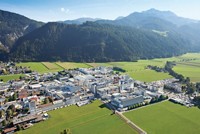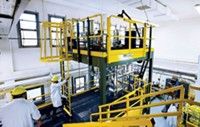Advertisement
Grab your lab coat. Let's get started
Welcome!
Welcome!
Create an account below to get 6 C&EN articles per month, receive newsletters and more - all free.
It seems this is your first time logging in online. Please enter the following information to continue.
As an ACS member you automatically get access to this site. All we need is few more details to create your reading experience.
Not you? Sign in with a different account.
Not you? Sign in with a different account.
ERROR 1
ERROR 1
ERROR 2
ERROR 2
ERROR 2
ERROR 2
ERROR 2
Password and Confirm password must match.
If you have an ACS member number, please enter it here so we can link this account to your membership. (optional)
ERROR 2
ACS values your privacy. By submitting your information, you are gaining access to C&EN and subscribing to our weekly newsletter. We use the information you provide to make your reading experience better, and we will never sell your data to third party members.
Business
Paying Attention To Manufacturing
Consortia aim to bridge the gap between drug development and manufacturing with a technology and engineering focus
by Rick Mullin
July 25, 2011
| A version of this story appeared in
Volume 89, Issue 30

Bad news in the pharmaceutical industry is not just about major drug companies tottering on the patent cliff even as they cut back on research and development. Some of the more recent negative headlines have had to do with manufacturing problems and related drug recalls.
Johnson & Johnson’s McNeil Consumer Healthcare unit may be the bad-news leader. The company has issued recalls of well-known brands including Tylenol, Sudafed, and Benadryl. The Food & Drug Administration estimates that J&J recalled more than 288 million drug product units in 2010. According to a recent report by the Pew Charitable Trusts, product recalls shot up from around 400 in 2008 to nearly 1,800 in 2009.
Regulators and drugmakers cite manufacturing as the key area of concern in securing the supply chain. Drug companies in the U.S. and Europe have been closing factories either in an outsourcing push or in the course of scaling down production of blockbuster drugs coming off patent. Cost cutting is on the front burner, and manufacturing is in line right next to research for cuts.
As a result, according to James R. Bruno, head of the consulting firm Chemical & Pharmaceutical Solutions, the stage is set for a decline in the drug manufacturing infrastructure. Layoffs are leading firms to wait longer between standard maintenance procedures, stretching 12-month cycles to 16 months or more. Plants once owned by huge drug companies are now in the hands of venture-capital-backed groups with no track record on maintenance. Add to that the decades that the drug industry has fallen behind other industries in manufacturing technology, and the landscape takes on a bleak aspect.
“The type of equipment used in the late 1800s and the type used in the late 1900s is pretty much the same, and that’s the equipment that we’re using today,” Bruno says. Current maintenance problems also date back. “Maintenance is maintenance,” he says. But the manufacturing environment has evolved: “What’s new is that we’re doing more with fewer people and with some nastier chemistry.”
Yet the pressure on profitability also presents drugmakers with incentives to improve manufacturing. The industry as a whole is investigating new technologies that reduce costs and improve quality, allowing plants to run with smaller-than-traditional operations staffs. In fact, two nonprofit consortia, one in the U.S. and one in France, have emerged from academic research centers to demonstrate technology alternatives.
In the U.S., a collective formed in 2004 at Purdue University launched the National Institute for Pharmaceutical Technology & Education (NIPTE) in 2007. Its purpose is interdisciplinary research on pharmaceutical process technology to improve safety and lower the cost of manufacturing.

The incentive for forming the group was FDA’s Critical Path Initiative, a report issued in 2004 on the science requirements for accelerating the commercialization of new drugs. “The report indicated that the science for taking a molecule from the lab to the market is not as advanced as the science for discovery,” says Prabir K. Basu, executive director of NIPTE. Part of the problem, he says, is that while the National Institutes of Health had provided about $30 billion annually to fund R&D in the early 2000s, no funding existed for developing technology to bring new molecules forward to production.
In addition to accelerating drug commercialization, Basu says, NIPTE hopes to advance manufacturing and associated analytical technology that is vital to supply chain security. The institute has proposed to Congress that FDA adopt a current Good Manufacturing Technology, or cGMT, standard in addition to its current Good Manufacturing Practice, or cGMP, standard. NIPTE also advocates introducing Raman and infrared spectroscopy and other techniques into the legally required regimen for testing imported products.
“At NIPTE we are trying to develop state-of-the-art science for drug development and drug manufacturing,” Basu says, explaining that the industry does not always respect the inherent connection between development and production. “We believe that outsourcing will continue as a trend. So to really ensure the quality of drugs, science is the answer. If a product is developed in such a way as to minimize defects in production, then your probability of safety is much higher.”
Although defect-proof design is a tall order, it is a stated goal in other industries that have adopted quality measures such as quality by design, a methodology developed by quality management pioneer Joseph M. Juran that incorporates final-product quality considerations in the earliest stage of product development. “The pharmaceutical industry is not up to speed,” Basu says. “We are 50 to 60 years behind the automobile industry.”
But the basic manufacturing technology also needs to change in the drug industry, where batch processes continue to dominate. A range of continuous-process technologies are already making their way into pharmaceutical factories. However, the industry, until recently, has not had an economic incentive to retool plants.
FDA has provided NIPTE with about $2.8 million in funding for the development of continuous-processing and other techniques, Basu says. NIPTE recently presented several case histories at a meeting in Washington, D.C. In one example, the institute demonstrated how product stability can be predicted and controlled in the production of gabapentin, a generic epilepsy drug, to improve quality and eliminate waste.
NIPTE is also working with FDA funding on a project to characterize excipients, a bulk drug category for which no cGMP standard exists. “Excipients make up 90% of the volume of any drug,” Basu says. “We are saying that excipients’ physical properties need to be assigned, starting with a quality target product profile. They need to be specified in any new drug application.”
In Toulouse, France, the European Institute for Innovative Processes, which goes by its French acronym MEPI, is on a course similar to NIPTE’s in exploring and demonstrating new technologies for pharmaceutical manufacturing. Laurent Pichon, MEPI’s business director, explains that the group began as an effort to revive the industrial chemistry community around the National Polytechnic Institute of Toulouse after a 2001 explosion at a nearby ammonium nitrate plant. Employment in the sector had dropped from more than 1,000 to about 80 after the explosion, which also devastated a phosgene operation at SNPE, France’s state-owned explosives and chemicals firm. The first two industrial partners were Sanofi and Pierre Fabre, two large French drug firms with plants in the area. SNPE is another partner.
MEPI has operated as an independent not-for-profit center since 2008. It hosts experiments by industrial clients interested in emerging manufacturing technologies. “The idea is primarily to switch from batch to continuous processing,” Pichon says. “Sometimes our clients come because they are looking for a cheaper process, but mostly because they have safety or quality issues. The new systems increase the homogeneity of mixtures and control reactions better, while producing fewer impurities so you can concentrate on the target molecule.”
Paul Hellier, industrial projects manager for Pierre Fabre, says MEPI allows drug companies access to new technologies outside their own facilities, without having to invest in equipment. He is mainly interested in continuous-processing and analytical technology. “There is a natural synergy between the two,” Hellier says, noting the quality advantages of online monitoring of continuous production compared with batch quality inspections.
MEPI’s flow-chemistry tools also interest Gerald Duc, scientific director for process development at Sanofi. Process efficiency is one consideration in evaluating new technology but so is supply chain safety, he says. “We have to develop industrial processes from a chemistry point of view, from a business and safety point of view, and from a cost-of-goods point of view,” he says. “The situation is not as simple as you might imagine.”
Duc and Hellier agree that improving chemical process development requires constant assessment of new technologies. “It is difficult to dissociate the technology from the process,” Hellier says.
There has, however, traditionally been a disconnect between pharmaceutical R&D and manufacturing process development, according to Rex Reklaitis, a chemical engineering professor at Purdue University who heads PharmaHUB, a collaborative website for pharmaceutical process development launched in 2008. “The general trend has been to separate drug substance and product,” he says. “Between the two, you pass drums of drug crystals. There hasn’t been much communication. But the industry is trying to bridge the two.”
Like Basu, Reklaitis is an advocate of quality by design. “In principle,” he says, “it encompasses everything from the manufacturing of the active ingredient to the product containing it.” Reklaitis, worked with NIPTE on its technology presentation in Washington, D.C., last month.
In addition to economic, quality-control, and safety benefits, improvements in process and analytical technology might put the brakes on outsourcing, Reklaitis says. “The underlying philosophy is that if we have more sophisticated manufacturing, automation, and on-line sensing, labor input will become less of a factor,” he says. It will also help secure the supply chain, he says, which would improve the prospects for manufacturing in the U.S. and Europe.
Richard L. Friedman, associate director of manufacturing and product quality at FDA’s Center for Drug Evaluation & Research, says the agency has not seen a serious decline in quality across the industry. The number of manufacturing-related recalls has remained steady in recent years, he contends, and the spike cited by Pew results from each product affected by an incident of contamination being counted separately.
“But we are seeing some troubling signals, due in part to poor management of outsourcers in some cases where companies’ external audit programs are not robust enough to ensure they have a reliable third party producing the goods,” Friedman says. “And there are some antiquated facilities in the industry now that, if updated, would be more dependable in terms of preventing defects and product failures.”
The agency supports implementing advanced technology, Friedman says, noting that FDA has launched a program to encourage the use of quality-by-design principles in product development.
Regarding the separate cGMT standard proposed by NIPTE, Friedman says the agency inspects for appropriate technology under its current auditing regime. “As part of the preapproval program, we make sure that the process, equipment, and facility are suitable,” he says. FDA avoids implementing prescriptive regulation regarding technology.
“What matters is that the company and the facility have the right quality-management drivers in place,” Friedman argues. “There must be a high level of regulatory scrutiny in this industry, but designing the system with incentives and disincentives to do the right thing is more effective than our getting involved in managing every technological detail of designing a process.”
For many major drug companies, this time of transition in manufacturing creates potential risk to supply chains. John F. Kelly, vice president of strategy and transitioning sites for Pfizer’s global supply division, says his company thoroughly vets the technology and quality systems of its outsourcing suppliers. The firm, he adds, generally remains involved with the new operators of sites Pfizer exits because most remain suppliers to Pfizer.
Be it in-house or outsourced production, maintaining quality begins with process design, Kelly says. “End-product testing is never enough,” he says. “To understand true quality of product, you have to understand the process with which it was made.”
The trick for the drug industry, Basu says, is to integrate engineering and pharmaceutical science in process development to accurately and predictably design, operate, and control processes. NIPTE, he says, is trying to demonstrate an alternative to the current empirical approach to process design in the drug industry—an alternative well illustrated by process design in the industrial chemicals manufacturing.
“In pharmaceuticals, we do not have anything similar to the field of chemical engineering,” he says. “We are trying to develop this new field.”





Join the conversation
Contact the reporter
Submit a Letter to the Editor for publication
Engage with us on Twitter